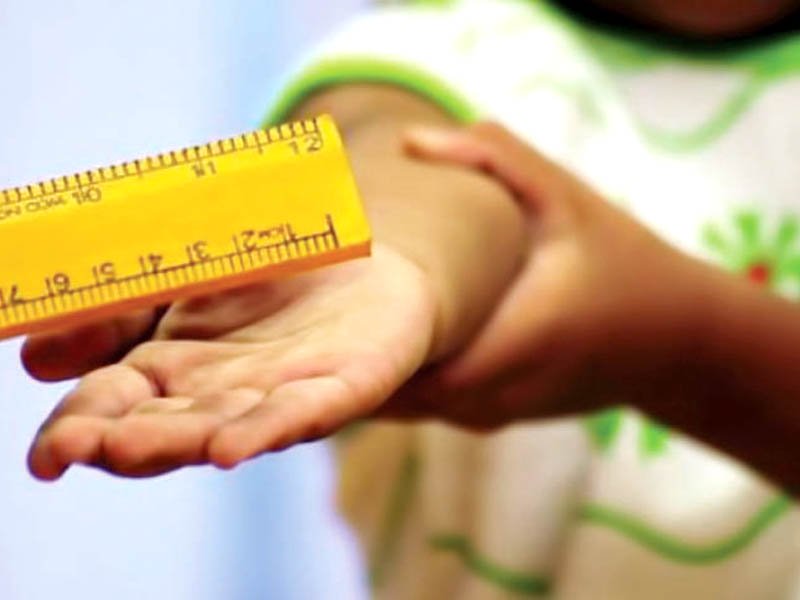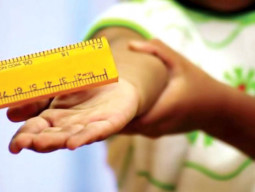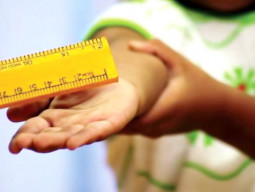
Most teachers and parents, at least those in low-income households, support corporal punishment in the classroom, despite the practice being banned in government schools since 2005 in the Punjab, according to a new study.
Asked if they agreed with the statement that a small amount of physical punishment is necessary for most children, some 20% of teachers said they ‘fully agreed’ and 47% said they ‘partially agreed’. Parents (and other family members of students) were even more supportive of corporal punishment, with 41% fully agreeing and 38% partially agreeing with the statement.
The study Stopping the Fear: Why Teachers Use Corporal Punishment – was conducted by Plan Pakistan, an NGO which has been running a campaign against corporal punishment since 2008.

It is based on surveys of teachers and parents in four districts in Pakistan – Chakwal in the Punjab, Gilgit in Gilgit-Baltistan, Thatta in Sindh and Lasbela in Balochistan.
Soofia Aziz, Plan Pakistan’s country learning adviser, said the study showed that there was widespread cultural and social acceptance for the idea that physical punishment of children was necessary.
Adult perceptions
A total of 137 teachers at 32 schools (half of them run by the government and the rest by NGOs or private organisations) were surveyed to assess their attitudes towards corporal punishment and what offences they felt justified it.
Twenty per cent fully agreed and 31% partially agreed that small amounts of physical punishment, given frequently, had no harmful effect on a child.
The respondents were presented with several scenarios and asked if they believed these merited corporal punishment.

Some 75% agreed (29% fully and 46% partially) that teachers were justified in beating students who were rude or disobedient. Sixty-five per cent (22% fully and 43% partially) felt that children who violated school rules deserved to be beaten. A majority also agreed that children who destroyed school property, stole from or beat other children, or who did not do their homework deserved physical punishment.
But 93% completely disagreed with children being punished for asking too many questions. Sixty-one per cent fully disagreed that children who were beaten performed better in exams, while 52% fully disagreed that fear of physical punishment motivated children to behave well in school.
The family members (including parents, uncles and aunts, elder siblings, grandparents, etc) of students in these schools believed even more strongly in the merits of corporal punishment, according to the study. Most of these lived in low-income households and had little education.
Fifty-four per cent of them fully agreed and 30% partially agreed that children who were rude to or disobeyed their teachers should be beaten. Eighty-five per cent (50% fully and 35% partially) agreed that children who stole and 81% (51% fully and 30% partially) that children who lied deserved physical punishment.
Aziz of Plan Pakistan said the study also showed age and gender differences among teachers who employed violence. Fifty-seven per cent of male teachers and 46% of female teachers used it, meaning that boys are more likely to be beaten than girls. Teachers older than 40 were also more likely to beat their students than teachers under 40.
“Teachers who experienced similar punishments during their childhoods are more likely to justify the use of corporal punishment as it is something they can relate to. It is a vicious cycle,” she said.
Students
The most common form of physical punishment handed out to children, according to 24% of the more than 300 students who were surveyed, was to be beaten on the palms of the hand with a stick or ruler. Twenty-two per cent said slaps on the face or head were most common. Other popular answers were to be forced to stand or sit in an uncomfortable position, to be struck with a stick or ruler on body parts other than the hand, and to be kicked.
Asked when they were beaten, many students said when the teacher was in a bad mood. Asked what put them in the bad mood, 25% said this happened when they did not do their homework and 24% when they did not learn or memorise their lesson.
According to a 2010 report of the Society for the Protection of the Rights of the Child (SPARC), up to 35,000 students drop out of high schools every year because of corporal punishment. And according to a 2009 study by Plan Pakistan and the Punjab government, almost 89% of children in rural areas and 92% in urban areas of the province reported to have been subjected to corporal punishment in some form. The practice was also reported to be most common in government schools, more so than private schools, non-formal schools and madrassas.
The report states that to counter the high prevalence of corporal punishment, the government should launch a mass campaign against it, upgrade assessment systems so students are evaluated by means other than rote learning, and set up a monitoring mechanism.
Legislation and interpretation
In September 2005, the Punjab government issued an order declaring that corporal punishment would no longer be practised at its schools. But according to the study, education officials at the district level were completely ambivalent towards it. While they do not exhibit negative attitudes, it said, they also “do not take a clear and firm stand against the practice”.
Rashid Aziz, the legal adviser for SPARC, said that there were provisions (in Section 337) in the Pakistan Penal Code (PPC) for injuries caused to a person through which parents of children who had been beaten could seek legal action against the offending teacher. He said that the teacher’s defence often employed Section 89 of the PPC (act done in good faith for benefit of child).
He said that there existed provincial laws that could be used as a remedy by aggrieved parents, such as Section 35 of the Punjab Destitute and Neglected Children Act, which outlaws cruel behaviour towards children by their guardians and carries a fine and prison term as punishment. Similar laws exist in Sindh and Khyber Pakhtunkhwa, he said, but none at the federal level.
Pakistan has also ratified the UN Convention on the Rights of the Child.
Published in The Express Tribune, June 27th, 2013.
COMMENTS (2)
Comments are moderated and generally will be posted if they are on-topic and not abusive.
For more information, please see our Comments FAQ


























1714024018-0/ModiLara-(1)1714024018-0-270x192.webp)









Most parents and teachers including madrasa teachers, who believe kids should be beaten should be persecuted including farhat hashmi of pechs little flower who abused me everyday as a 4th grade student and i was too afraid to speak against it
Is this a wonder that Pakistani society is so primitive, violent and ruthless.
It is scientifically proven, that the mind might forget the inflicted pain of the childhood, but the body never forgets !!!!
Suddenly as a grown-up one gets creeps or the heart misses the beat and one does not even know the reason!!! Why?
Because in a particular moment, a particular sight, a particular noise, a particular thought or a particular association, reminds the body of a dreadful pain and humiliation of the childhood.
This all causes deep anger and they REVENGE from the society.
The criminals and killers of today are physically and psychically abused children of this society.